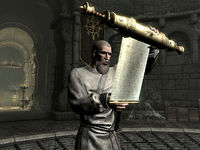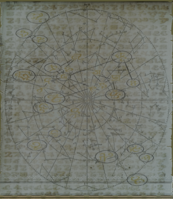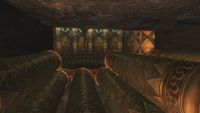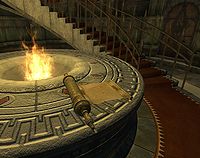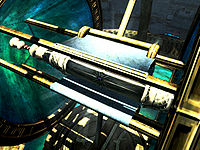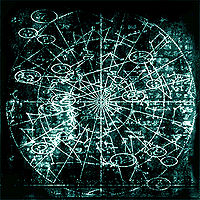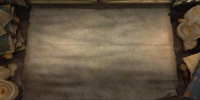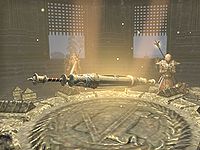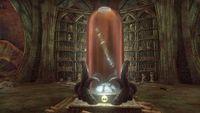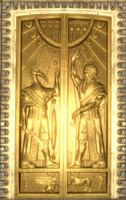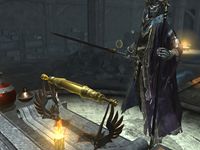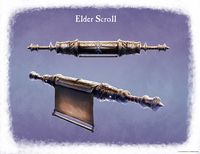Lore:Elder Scrolls
The Elder Scrolls (Kelle in the Dragon Language),[2] also called the Aedric Prophecies (a name of questionable accuracy), are scrolls of unknown origin which archive both past and future events.[3]
The exact number of Scrolls in the world is unknowable. They "do not exist in countable form", and they may disappear and reappear from moment to moment and place to place.[4][5]
Contents
Reading an Elder Scroll[edit]
Elder Scrolls contain writing in an unknown script and what seem to be star charts depicting Constellations. According to one scholar, for an individual with "no training in the history or knowledge of the Scrolls", there is nothing revelatory about them and there are no adverse side affects from reading them.[6]
Without preparation, a Scroll will take the sight or sanity of a reader who understands it's importance. They will, however, get a glimpse of the Scroll's contents, which may include insight into the future, the past, or the nature of reality.[5][6][7][8][9] When the Scrolls are attuned to the timeless time of a Dragon Break in an attempt to see what happened during the Middle Dawn, their glyphs always disappear.[10]
Due to the risks involved, the task of storing, cataloging and reading the Elder Scrolls has traditionally fallen on the Cult of the Ancestor Moth. The Cult had devised a method of reading them, known as the Ritual of the Ancestor Moth, that used the aid of the sacred Ancestor Moths themselves to dampen the Scrolls' effect on the Moth Priests' sight and mind. Reading a Scroll still blinds them temporarily. This blindness lasts longer and longer with each reading,[11] and their returned eyesight degrades until it is gone for good.[6][12] Urag gro-Shub, an experienced scholar of the College of Winterhold, believed that the blindness afflicted by the Scrolls was a "price" taken by the Divines in return for their knowledge.[7] Those who read Elder Scrolls regularly begin to see the inscrutable script within as the letters of their own first language.[13]
Certain individuals such as the Last Dragonborn have managed to read an Elder Scroll without permanent blindness or madness, despite knowing their importance, gaining knowledge from them and having little to no training on how to avoid their side effects. Some believe that the Scrolls themselves allow these individuals to read them.[14][5]
The Dwemer invented a machine which could transcribe an Elder Scroll, and the transcription could be read safely.[8] It is unclear whether this transcription reveals all of the Scroll's revelatory content, or only a fraction of it.
If the knowledge contained within an Elder Scroll is of the future, it may change from reader to reader, and from reading to reading. Until a prophecy is fulfilled, the true contents of an Elder Scroll are hazy, malleable, and uncertain.[13][UOL 1] Once the events within come to pass, its contents become fixed, identical to all who read it.[3][12][13] Through the actions of a Hero, the contents of a Scroll are made history and become "true". For this reason, a Hero can be considered the scribe of the next Elder Scroll, the one in which the prophecy has been fulfilled into a fixed point, negating its precursor.[15][UOL 1]
Origin & Nature of the Scrolls[edit]
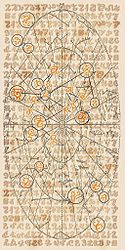
The Scrolls are fragments of creation from outside time and space.[16] They have been variously described as "bits of the divine made substance" with no author,[7] "gods-built/created",[2] "blasphemies" which "the gods would fear to tamper with",[17] and as points of light in a knowledgeless void.[18] They are also said to be indestructible.[5] While many Scrolls that have been collected are small enough to be held by two hands, it is suggested that the Scrolls can also reach enormous sizes, with the smooth cylindrical metal core of the Adamantine Tower itself said to be a container for a massive Elder Scroll.[19][UOL 1][UOL 2]
The term "Aedric Prophecies" is disputed by some scholars,[3] and the Moth Sister Terran Arminus asserts that "prophecy" is an inaccurate word for what amounts to a side-effect of the Scrolls' intrinsic nature. According to her, the Scrolls are "woven into" the future, "as well as the present, and the past, and every other aspect of this reality we call the Mundus".[13] While any connection the Scrolls have to the Aedra are still unclear, the Scrolls are in no way fragments of Aka.[UOL 2]
While it is impossible for magic to affect the contents of an Elder Scroll that has come to pass,[3] the Ayleid king Valentis developed an incantation which binds his brother to a specific future described in an Elder Scroll. It is uncertain whether this incantation causes the future in the scroll to come to pass immediately, or if the scroll's contents and Celemaril truly become bound together in some way.[20] The dragon Shulkunaak explains that the Scrolls can affect all possible futures.[21]
According to the dragon Paarthurnax, the Scrolls do not exist, yet always have existed. He believed that the Last Dragonborn's carrying of an Elder Scroll was irrefutable proof that the Last Dragonborn was Doom-Driven, blessed by Akatosh, and had the "very bones of the earth" at their disposal.[2]
The Cult of the Ancestor Moth believes that the contents of the Elder Scrolls "exceed even the gods, both aedra and daedra." The Cult implies some connection between the Scrolls and the "dissipated" souls of mortals, claiming that both exist in a state where time is irrelevant.[11][22][13] The Moth Priest Dexion Evicus insists that the Scrolls "have a mind of their own", and can appear, disappear, and allow themselves to be read at will.[5] The Scrolls cannot be reliably counted at all, because their number is not fixed.[4][UOL 3]
The scholar Septimus Signus, who is claimed to have been driven mad by the Scrolls, argues to the contrary that the knowledge Scrolls grant "is a passing awareness when compared to the encompassing mind of divinity." He similarly claims that the Scrolls see "left and right in the stream of time. The future and past are as one: Sometimes they even look up. What do they see then? What if they dive in? Then the madness begins."[8] He also was the author of a book titled Ruminations on the Elder Scrolls, a "philosophical view" on their role.[18]
Some texts accredit Mnemo-Li with collecting "all the songs" made by mortals and the keeping of the Elder Scrolls.[UOL 2]
History[edit]
An Elder Scroll was used by Felldir the Old to cast Alduin forward in time, ending his reign in that age. This use of the Elder Scroll shattered time at the spot where Alduin was banished, creating a Time Wound on the Throat of the World.[23][2]
Long ago, the Dwemer devised a means to extract knowledge from the Scrolls without requiring someone to sacrifice their sight. Complex machinery interfaces with the Scroll and draws out information, inscribing it onto a metal Lexicon which can then be read by those with the requisite knowledge.[8] It is unknown how the quality or quantity of the information gained this way compares to that when read directly from a Scroll.
Second Era[edit]
Hermaeus Mora, the Daedric Prince of Forbidden Knowledge, was known to possess a number of Elder Scrolls circa 2E 582. They can sometimes be seen floating within vats in his infinite realm of Apocrypha.[24]
Numerous Elder Scrolls were stored at the White-Gold Tower within a chamber known variously as the Imperial Library, the Hall of Records, and the Elder Library.[4][25][26] During the Three Banners War in the Second Era, the Imperial City fell to hordes of Daedra. To protect the scrolls, the Cult of the Ancestor Moth hid several of them around the grounds of the Temple of the Ancestor Moths in northeastern Cyrodiil. Eventually, troops from each alliance found the scrolls and stole them from the moth priests.[27] Across Cyrodiil, each alliance built vast holy temples to house the scrolls they had stolen. The temples were built close enough to the battlefields to bestow the scrolls' blessing onto the troops. It is theorized by Moth Priest Euclidius, that the real reason the Scrolls bestowed "blessings" on the troops possessing them was that, in holding them, the troops performed a collective osmotic absorption of the prophecies therein, and were unwittingly influenced to make the decisions that would coincide with the probability of events that would lead them to victory. Unknowingly influenced to make the choices that would help them triumph by the prophecies of the Scrolls.[28][29][30] After the war ended, many scrolls were re-housed within the Imperial Library.
During this time the Daedric minions of Molag Bal used an Elder Scroll housed within the White-Gold Tower in an attempt to enact the Planemeld Obverse, a process which would result in Coldharbour being pulled into Nirn, bringing the mortal world under the control of Molag Bal. This plan was ultimately foiled by The Vestige.[31][12][32]
Third Era[edit]
While the Cult of the Ancestor Moth would report information to the Elder Council, Ocato had stated that neither the Elder Scrolls nor the ancestor moths had ever provided them with much "practical information".[UOL 4] During the Imperial Simulacrum in the late Third Era, many organizations across the provinces attempted to decipher an Elder Scroll with an artifact, usually a tablet that was key in the process. These included the Mages Guild of Winterhold[33] and Corinthe.[34] The Brotherhood of Seth used a code from an ancient map to locate the Crypt of Hearts on an Elder Scroll, so that the Eternal Champion could acquire a piece of the Staff of Chaos.[35] Queen Blubamka of Rihad tasked the Champion with retrieving a special parchment that was stolen band of goblins led by Golthog the Dark. The parchment was able to decipher an Elder Scroll that would in turn reveal Fang Lair's location. The Eternal Champion returned with the parchment from the goblins in Stonekeep and traveled north into Fang Lair, where they found their first piece of the Staff.[36]
Circa 3E 422,[37] Count Corvus Umbranox wished to retire from his position as leader of the Thieves Guild and return to his wife, Countess Millona Umbranox of Anvil. However, he had been cursed upon donning the Gray Cowl of Nocturnal: his previous identity had been erased from the minds of others, forcing him to assume the identity of the infamous Gray Fox.[38] This curse had been placed upon the Cowl by Nocturnal herself when it was stolen from her by the first Gray Fox, Emer Dareloth. Umbranox found himself unable to reveal his true identity to anyone, instead simply appearing to them as a stranger.[37] Undeterred, Umbranox spent the next eleven years planning a heist to steal a particular Elder Scroll from the Imperial Palace in order to break the curse. Circa 3E 433, he enlisted the aid of the Hero of Kvatch to plan and execute the heist. With the Elder Scroll in his possession, Umbranox invoked its powers to rewrite history as if Dareloth had never stolen the Cowl from Nocturnal, thereby breaking the curse, and allowing the Thieves Guild to benefit from an altered history where their first Guild Master was still able to operate in the normal world of business and society.[39][37]
Following the Palace break-in, rumors circulated that a Scroll had been stolen by a master thief.[40] In response to these rumors, an Imperial Librarian attempted to take a complete inventory of the Scrolls, but the effort proved fruitless as their numbers and placement seemed to fluctuate for no discernible reason.[4]
Fourth Era[edit]
Around 4E 175, the Elder Scrolls mysteriously vanished from the Library, and were scattered across Tamriel.[5] Circa 4E 180, a previously undiscovered Elder Scroll was found within the statue of the founder of the town of Rivercrest, Cyrodiil. As an Elder Scroll can affect all possible futures, the Warrior used this Elder Scroll under the guidance of the dragon Shulkunaak, to bind the immortal sorcerer-king Celemaril to the one future where he failed to escape the spell that was used to imprison him anew, ensuring the end of his threat to the world despite his unkillable nature.[21][20]
The year 4E 201 saw the discovery of three Elder Scrolls. Two Elder Scrolls were discovered in Skyrim itself, one hidden in the Dwemer city Blackreach and the other in the ancient ruin of Dimhollow Crypt. The third was located in the Soul Cairn. One of these Scrolls was used by the Last Dragonborn to cast himself back to the moment of the creation of the Throat of the World Time Wound and learn the Shout Dragonrend. The three Scrolls were also used by the Dragonborn to divine the location of Auriel's Bow.[14][2][41]
Known Elder Scrolls[edit]
- Elder Scroll (Blood)
- Elder Scroll (Celemaril Light-Bringer)
- Elder Scroll (Dragon)
- Elder Scroll (Nocturnal's Curse)
- Elder Scroll (Planemeld Obverse)
- Elder Scroll (Sun)
- Elder Scroll of Alma Ruma
- Elder Scroll of Altadoon
- Elder Scroll of Chim
- Elder Scroll of Ghartok
- Elder Scroll of Mnem
- Elder Scroll of Ni-Mohk
- Elder Scroll of Rhunen
Gallery[edit]
Notes[edit]
- The Elder Scrolls are retroactively the namesake of The Elder Scrolls franchise. When Arena transitioned from an action combat game into an RPG, "The Elder Scrolls: Chapter I" was added to the title, not only to better advertise that it was an RPG (which was a prerogative), but also to evoke a sort of tome like novel, something that new Chapters could be written into down the line. The team eventually picked "The Elder Scrolls", which took its name from Tamriel's mystical tomes of knowledge that told of its past, present, and future. At its core the series was designed to support Dungeons & Dragons style campaign packs, with varying Chapters big and small being added to the original game over time (what today we would call an Expansions or Add-Ons). However, at the time of this thought experiment, the company really didn't have the infrastructure to implement and support such a system, and seemingly opted to designate future Chapters as being the mainline games of the series.[UOL 5][42]
- In the late 1990s, Bethesda had a plan to make a website with a lot content about where we they had "really" got the Elder Scrolls stories, involving fictional accounts of finding them in the three physical Elder Scroll replicas in the basement (two perfectly preserved, one broken, the latter of which was never used). The developers would get to "play" with the Scrolls and mull over the stories within, such as how they "found" the tale of Cyrus and "adapted" it into The Elder Scrolls Adventures: Redguard. The developer diaries would contain "conversations" of how they would needed to change the stories found within the Scrolls to make it them playable products, ultimately "compromising" to streamline the esoteric stories into easily digestible video games. It would have also given the developers a way of saying that they knew all future games were going to have discrepancies.[UOL 2] The website ultimately never came to fruition, though Michael Kirkbride referenced this plan by jokingly saying all the Elder Scrolls seen in the games are copies of the "real" Elder Scrolls, found in the form of three giant cylinders kept in the vaults beneath White-Gold Tower.[UOL 1]
- Runes written on the Elder Scrolls and their covers seem to be the same kind of runes that are found on the amulets of the Elder Council, which seem to be made of a metal similar to that of the Elder Scrolls' covers and crimped with a similar purple gem.
- The names of the Elder Scrolls that were fought over during the Three Banners War (Alma Ruma, Altadoon, Chim, Ghartok, Mnem, Ni-Mohk) are all words mentioned in Mankar Camoran's Commentaries on the Mysterium Xarxes.[43]
- According to some legends, the Druids of Galen were in possession of an Elder Scroll, and followed its guidance to arrive to their new home on Y'ffelon.[44]
- A Moth Priest's interpretation of the contents of an Elder Scroll can be seen in Terran's Notes.
See Also[edit]
- For game-specific information, see the Oblivion, Skyrim, Elder Scrolls Online, and Blades articles.
- Elder Alphabet — The unknown script the Scrolls are written in
Books[edit]
- An Accounting of the Scrolls by Quintus Nerevelus, Former Imperial Librarian — An author's report on the Elder Scrolls and his subsequent entry into the Cult of the Ancestor Moth
- Divining the Elder Scolls — A fragment of information about the nature of the Elder Scrolls
- Effects of the Elder Scrolls by Justinius Poluhnius — A thesis on the four different types of readers of the Elder Scrolls
- Elder Scroll — The contents of one the mysterious Elder Scrolls
- Lost Histories of Tamriel — Excerpt concerning the Aedric Prophecies, otherwise known as the Elder Scrolls
- Moth Sister Terran Arminus Answers Your Questions by Moth Sister Terran Arminus — A moth sister answers questions on lore
- Pension of the Ancestor Moth — A Temple novice's initiatory pamphlet on the Cult of the Ancestor Moth
- Ruminations on the Elder Scrolls by Septimus Signus, College of Winterhold — A philosophical view on the role of the Elder Scrolls
References[edit]
- ^ The Elder Scrolls: Legends - E3 2015 Teaser Trailer
- ^ a b c d e Paarthurnax's dialogue in Skyrim
- ^ a b c d Lost Histories of Tamriel
- ^ a b c d An Accounting of the Scrolls — Quintus Nerevelus, Former Imperial Librarian
- ^ a b c d e f Dexion Evicus' dialogue in Skyrim: Dawnguard
- ^ a b c Effects of the Elder Scrolls — Justinius Poluhnius
- ^ a b c Urag gro-Shub's dialogue in Skyrim
- ^ a b c d Septimus Signus' dialogue in Skyrim
- ^ Divining the Elder Scolls
- ^ Where Were You ... Dragon Broke — Various
- ^ a b Pension of the Ancestor Moth
- ^ a b c Sister Terran Arminus' dialogue in ESO
- ^ a b c d e Moth Sister Terran Arminus Answers Your Questions — Moth Sister Terran Arminus
- ^ a b Events of Skyrim
- ^ Light the Dragonfires epilogue in Oblivion
- ^ Description in Blades
- ^ Arngeir's dialogue in Skyrim
- ^ a b Ruminations on the Elder Scrolls — Septimus Signus, College of Winterhold
- ^ Pocket Guide to the Empire, 1st Edition: High Rock — Imperial Geographical Society, 2E 864
- ^ a b Events of Blades
- ^ a b Shulkunaak's dialogue in Blades
- ^ The Distributed Soul — Abbot Crassius Viria
- ^ Alduin's Bane quest in Skyrim
- ^ The Feral Gallery, The Underweave and elsewhere in Apocrypha in ESO: Necrom
- ^ The Wolf Queen, v1 — Waughin Jarth
- ^ Events of Oblivion
- ^ Sandana Axius' dialogue in ESO
- ^ Protector Arfire's dialogue in ESO
- ^ Grand Warlord Dortene, overheard at a Daggerfall Covenant camp — Grand Warlord Dortene
- ^ Moth Sister Terran Arminus Answers Your Questions — Moth Sister Terran Arminus
- ^ Planemeld Obverse quest in ESO
- ^ Molag Kena's dialogue in ESO
- ^ Thelen Kaarn's dialogue in Arena
- ^ Turamane ap' Kolthis' dialogue in Arena
- ^ Halfas Varn's dialogue in Arena
- ^ Fang Lair story quest in Arena
- ^ a b c The Gray Fox's dialogue in Oblivion
- ^ Instructions: the Gray Cowl — Office of the Unseeing Eye
- ^ The Ultimate Heist quest in Oblivion
- ^ Palace Break-In?
- ^ Events of Skyrim: Dawnguard
- ^ The Elder Scrolls - 10th Anniversary article
- ^ Mythic Dawn Commentaries — Mankar Camoran
- ^ Systres History: Volume 1 — Trilam Heladren, Associate Dean of Eltheric History, University of Gwylim
Note: The following references are considered to be unofficial sources. They are included to round off this article and may not be authoritative or conclusive.

